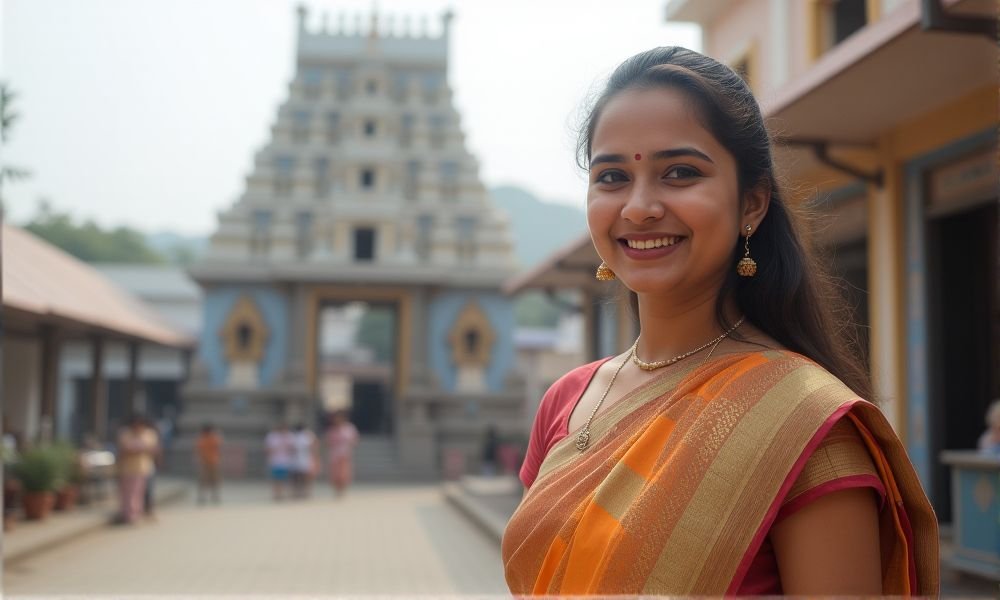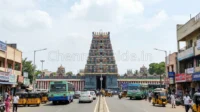Arulmigu Vadapalani Andavar Temple (Vadapalani Murugan Temple)
Arulmigu Vadapalani Andavar Temple Chennai – Complete Devotee Guide
1. About Temple
Arulmigu Vadapalani Andavar Temple stands as one of Chennai’s most beloved spiritual destinations, uniquely known for housing Lord Murugan with footwear—a rare sight in Hindu temples symbolizing humility and readiness to help devotees. This sacred shrine attracts thousands of devotees daily who seek blessings for marriage, career success, and life solutions, making it an essential stop for anyone exploring Chennai’s spiritual tourism landscape.
2. History of Temple
The temple’s remarkable origin dates back to the late 19th century when devotee Annaswami Nayakar, suffering from chronic stomach ailments, initially worshipped a painted portrait of Lord Murugan in a small thatched hut. After a divine vision instructing him to worship at home rather than travel to distant temples during harsh weather, he established this sacred space around 1890. Following Annaswami’s passing, his disciple Rathinasamy Chettiyar continued the tradition and installed the main idol, with temple construction completed and the Kumbabhishekam performed by 1920. The temple gained fame through the “Arul Vaakku” (divine utterances) tradition, where devotees believed the priests’ words provided solutions to life’s challenges.
3. Architecture of Temple
The temple showcases magnificent Dravidian architecture with its striking 40.8-meter-tall Rajagopuram adorned with intricate stucco figures depicting legends from the Skanda Purana. The eastern tower uniquely displays 108 classical Bharatanatyam dance gestures, making it an architectural marvel. The temple complex features spacious mandapams for marriages and religious discourses, a sacred temple tank in front, and courtyards housing multiple shrines including Varasiddhi Vinayaka, Chokkanathar, Meenakshi Amman, and specialized sannidhis for planetary deities. The temple’s golden chariot (Thanga Ratham) and the sacred fig tree (Thala Vriksham) where devotees tie small swings for progeny add to its spiritual significance.
4. Presiding Deity and Significance
Lord Murugan, worshipped here as Vadapalani Andavar, is the main deity whose idol closely resembles the famous Palani temple deity. The unique aspect of this temple is that Lord Murugan is depicted wearing footwear (paduka), symbolizing the abandonment of arrogance and his eagerness to assist devotees—indicated by his left foot positioned forward in a walking stance. The temple also houses shrines for his consorts Valli and Devasena, along with other deities including Ganapati, Shanmuga, and a special shrine for Angaaran (Mars), whose ruling deity is Murugan. The temple is particularly renowned for its belief that devotees who cannot visit the original Palani temple can receive equal blessings here.
5. Temple Festival
The temple celebrates numerous vibrant festivals throughout the year, with Vaikasi Brahmotsavam being the grandest 11-day celebration in April-May featuring the golden chariot procession on the seventh day. Major festivals include Thaipusam (January-February), Panguni Uthiram (March-April), Maha Skanda Shasti (October-November lasting 6-10 days), Vaikasi Visakam, monthly Krithikai celebrations, and special observances during Tamil New Year. The temple remains open throughout the day during these festivals, with elaborate processions, special abhishekams, and cultural performances drawing massive crowds.
6. Address
Arulmigu Vadapalani Andavar Temple
Andavar Koil Street, Vadapalani
Chennai – 600026, Tamil Nadu, India
Phone: +91 44 2483 6903 / +91 80723 98360
Landmark: Near Vadapalani Metro Station & Forum Vijaya Mall
7. Temple Opening and Closing Hours
Daily Timings:
- Morning: 5:00 AM – 12:30 PM
- Evening: 4:00 PM – 9:30 PM
- Special Tuesday Timing: Temple reopens at 3:00 PM (instead of 4:00 PM)
- Festival Days: Continuous opening from 5:00 AM – 9:30 PM
- Special Poojas: Ardhajama pooja extends until 10:00 PM on Tuesdays and Fridays
8. Best Time to Visit
The optimal visiting time is early morning (5:30-7:00 AM) or evening (after 5:00 PM) for peaceful darshan. October to March offers the best weather conditions, while festival periods like Thaipusam, Vaikasi Brahmotsavam, and Skanda Shasti provide unique spiritual experiences despite larger crowds. Tuesdays, Saturdays, and Sundays tend to be busier. Avoid visiting during peak summer months (April-June) due to high temperatures.
9. Entry Fee
- General Darshan: Free
- Special Darshan: ₹20 (regular days), ₹50 (special days), ₹100 (festival days)
- Various Services: Archana (₹5), Hair offering (₹10), Marriage ceremonies (₹2000), Thirukalyanam (₹3000), Vehicle poojas (₹10-30)
- Parking: Available near temple, charges vary
10. Special Pooja Details
The temple follows traditional six-time daily pooja schedule: Palliyarai (5:30-6:00 AM), Kalasandhi (6:30-7:00 AM), Uchikala (12:00-12:30 PM), Sayaraksha (5:00-5:30 PM), Ardhajama (9:00-9:30 PM on most days, extended to 10:00 PM on Tuesdays/Fridays). Special services include 108 Sanga Abhishekam (₹2500), Milk Abhishekam (₹250), Santhana Kappu for childbirth blessings (₹1400), and Golden Chariot processions (₹1500). Advanced booking recommended for special rituals.
11. Website Link
Official Website: https://vadapalaniandavar.hrce.tn.gov.in/
HRCE Portal: Tamil Nadu Hindu Religious and Charitable Endowments Department
Online Services: Temple timings, festival calendar, and booking information available through official channels
12. Nearby Landmarks
- Forum Vijaya Mall (500m): Major shopping and entertainment complex
- Vadapalani Metro Station (300m): Direct connectivity to Chennai Metro
- CMRL Bus Terminal (1 km): Major bus connectivity hub
- Kodambakkam Railway Station (2 km): Suburban train access
- Tamil Nadu Agricultural University (1.5 km): Educational landmark
- Saligramam (2 km): Residential and commercial area
13. How To Reach Temple
By Metro: Vadapalani Station on Chennai Metro Green Line (5-minute walk)
By Bus: Multiple MTC routes including 12X, 25, 26, 37, 170C stop at Vadapalani Kovil
By Train: Kodambakkam Railway Station (2 km), Chennai Central (12 km via metro)
By Air: Chennai Airport (11 km, 30-40 minutes by road)
By Auto/Taxi: Easily accessible from any part of Chennai (₹50-200 depending on distance)
By Car: Ample parking available near temple complex
14. Top Hotels Near Temple
15. Other Temples Nearby
- Madhya Kailash Temple (1.5 km): Shiva temple in Sentamil Nagar with peaceful ambiance
- Vengeeswarar Temple (1 km): Ancient Shiva shrine within Vadapalani
- Sri Garbarakshambigai Temple (2 km): Goddess temple in Kodambakkam, known for childbirth blessings
- Ayyappan Temple KK Nagar (3 km): Popular Sabarimala Ayyappa shrine
- Sri Raghavendrar Brindavanam (2.5 km): Raghavendra Swamy temple in Saligramam
Experience the divine grace of Lord Murugan at Chennai’s most accessible and spiritually vibrant temple, where ancient traditions meet modern convenience in the heart of the city.






